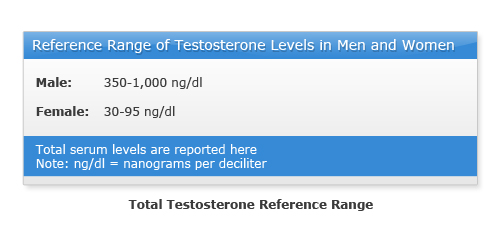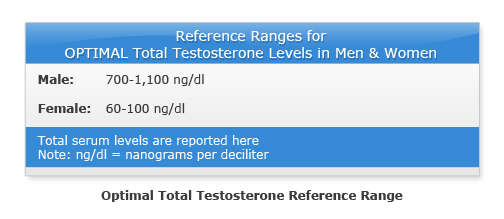
What is Low T?
The hormone testosterone is often referred to as 'Test' or just plain 'T'. This hormone is generated by the endocrine system and the pituitary gland, and then actually produced within the testicles. Testosterone serves as the male body's primary natural hormone and is responsible for the proper development of male sexual characteristics. Although routinely described as a sex hormone, testosterone actually governs numerous functions throughout the body including several aspects of development from birth onward. Testosterone's duties involve everything from determining your gender, and regulating pubertal changes, through providing for male potency (sexual desire & function), to muscle distribution and the partitioning of bodily fat. It is also an integral part of male well-being, in that it plays a giant role in your physiological, biological, and sexual health while influencing such important elements as stress coping capacity, red blood cell count, mental acuity (clarity, focus & concentration, memory & recall), bone density, sperm production, and immunity support. Although testosterone is a naturally occurring hormone within both males and females, male production is approximately ten times greater.
Normal T Levels
The chart below illustrates the medically accepted ranges for what's considered the normal upper and lower limits for testosterone levels.

A well-trained physician knows too look at the whole enchilada and not to treat the labs but to treat the patient. The below chart represents optimal Total and Free Testosterone Levels in men:

Male testosterone levels are dictated by your age, genetics, lifestyle, and additionally influential external variables. Using accepted averages, men's testosterone levels breakout by age and level to: 19-24, 700; 25-34, 658; 35-44, 617; 45-54, 606; 55-64, 562; 65-74, 524; 75-84, 471; 85-100, 376.
Your testosterone production slowly declines with age by about 1 percent per year, following age 30. So what then is 'Low T', and what does having it mean?
Low T
'Low T' is any testosterone level that's below what is considered the floor, or lower limit for normal Test levels. Which is even lower than what is healthy or optimal 700-1100ng/dl. Therefore, everyone with testosterone levels below 350 ng/dl has low T, and should be experiencing the symptoms of it and people in the 700 range can be experiencing symptoms of it too. I know its confusing...thats why you can't look at Total Testosterone levels alone; free testosterone level is the real important one here since it is the only part that is unbound thus "freely" responsible for healthy muscles, bones and mojo. generally speaking most men will start expericing symptoms of declining testosterone when their free testosterone reaches 150pg/dl or 15pg/ml and intensify as levels continue to decline. However other factors play apart when it comes to diagnosing for Low testosterone, symptoms, health history, ect. A well trained physician knows too look at the whole enchilada and "not to treat the labs...treat the patient." Regardless of the 'why', whether your low T is the result of pollutants-petrochemical-in the environment. andropause (a condition associated with the physical and emotional change men experience as they age), or any of the possible causes below, if your levels fall below that benchmark you're suffering from low T.
General causes of this condition include:
- Developmental and genetic disorders
- Chronic illnesses
- Kidney problems or complete failure
- Excessive stress
- Viral infections
- History of surgery
- Bodily traumas
- Tumors - Injury to, or loss of the testicle(s)
- Extensive nutritional deficiency
- Too much iron in the body, a condition known as Hemochromatosis
- Recurrent bleeding
- Specific medications, like opiates and steroids
- Genetic conditions like Klinefelter's Syndrome (an extra 'X' chromosome)
- Radiation therapy or chemotherapy
- Sarcoidosis, or other inflammatory diseases
- Liver and kidney disease
- Specific autoimmune disorders
- Alcoholism
- Obesity
- Sudden and/or extensive weight loss
Are You Suffering from Low T?
The symptoms of low T are characterized by:
- Low hemoglobin
- Decreased energy
- More visceral fat
- Bone density loss and increased risk of osteoporosis, breaks and fractures
- Reduced lean muscle mass, and a decrease in muscular strength
- Poor lipid and cholesterol values
- Less body hair (both overall thickness and amount)
- Mood swings that may seem like irritability, fatigue, anger or depression
- Diminished sexual drive, and reduced sexual functioning
- Reduced body fat burning capacity
Low T Testing
Low T is measured by a blood test used to determine the serum levels of testosterone, both bound (attached to Sex Hormone Binding Globulin - SHBG) and 'free' (unbound) available testosterone. Results that return a total serum level below 350 ng/dl and or a free testosterone level below 200 pg/dl are deemed low and garner a diagnosis of Low T. Due to possible influences in testosterone production, the blood sample should be drawn in the morning prior to daily bodily stressors such as exercise, medication, work, etc.
The testosterone analysis involves an evaluation of other measurements as well, including LH (luteining hormone), and FSH (follicle stimulating hormone). These measures are especially weighted in men who may be suffering from andropause.
Prostate Exam (Pre-Therapy)
Ideally, every male preparing to undergo testosterone replacement therapy should submit to a prior prostate examination, to both evaluate and document the status of his prostate gland. Typically if a man has a PSA level higher than 2.6 he should have a Digital Rectal Exam (DRE) and be cleared by a urologist before treatment. Any abnormalities, urinary complaints, or hypertrophy, should be documented and addressed at this time as well.
It's a good idea to have both the PSA (prostate specific antigen) blood test along with the general physical prostate exam. If PSA values are elevated, it should be followed up with the PSA II test, which is used to identify prostatic hypertrophy. Men who test positive for prostate cancer should finish cancer therapy before testosterone treatment and be cleared by their urologist before starting therapy.
TRT
Testosterone replacement therapy (TRT) is the name of the medically customized treatment of low testosterone. TRT preparations, which include individually prescribed dosages and frequencies, are administered to restore normal hormonal function. In some instances, certain pituitary gland problems require non-hormonal medications, the replacement of other bodily hormones, the surgical removal of a pituitary tumor, or radiation treatment. However, generally speaking TRT is all that's required to effectively reverse the negative symptoms of low T, and rebalance your body's testosterone levels.
